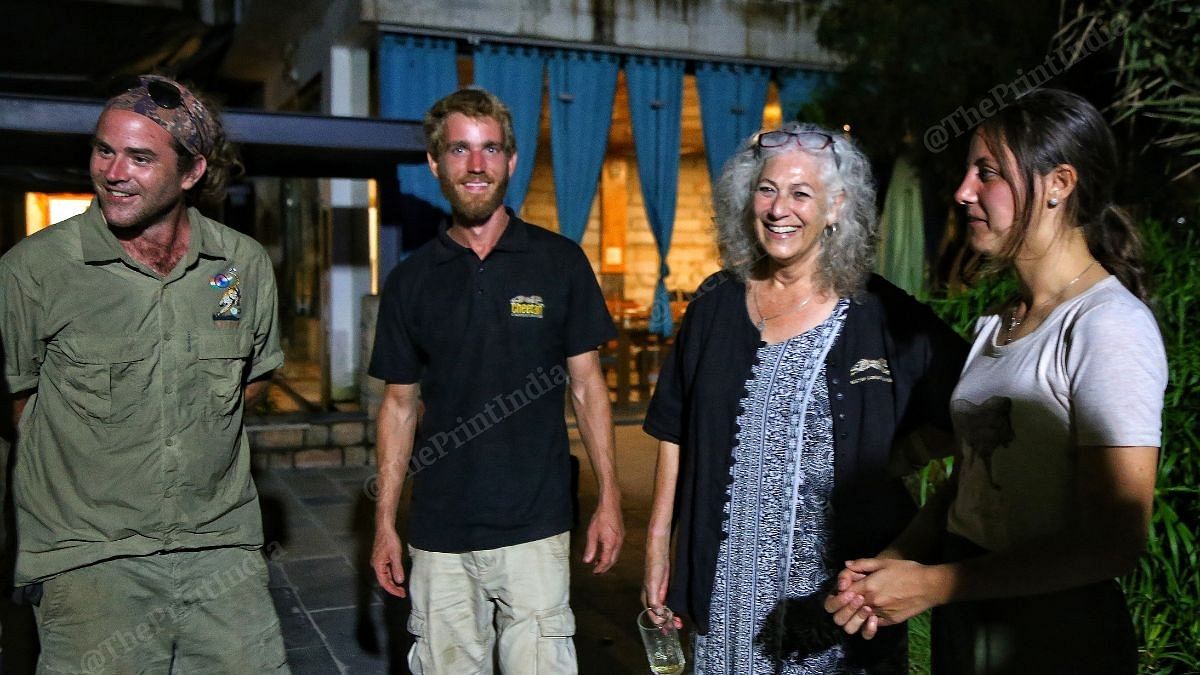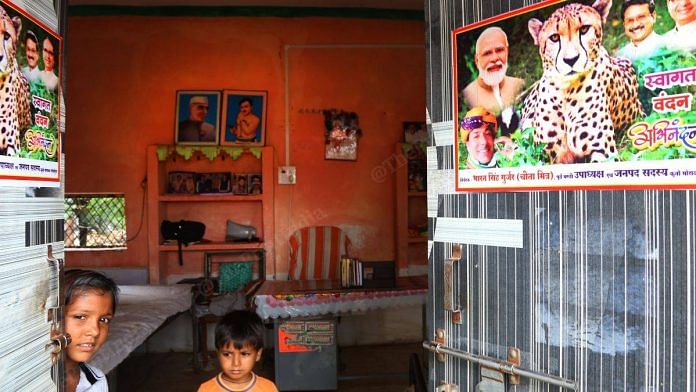Sesaipura, Madhya Pradesh: The eight newly translocated cheetahs from Namibia were “freaked out” by the hundreds of people at Kuno at the time of their release, but have since calmed down and are adjusting well, the team of experts from South Africa and Namibia told ThePrint.
“By the time we were able to release them, it had been well over 24 hours so they [cheetahs] were glad to stretch their legs and get out. But they were also kind of freaked out because there were a lot of people,” Cheetah Conservation Fund executive director Laurie Marker said. “These are wild animals, and they were trying to get away from everybody. So, we had to try to do crowd control and asked people to step back.”
Prime Minister Narendra Modi released the cheetahs into quarantine enclosures on Saturday in front of hundreds of people, including politicians, state and district administration officials, forest staff, police, and “cheetah mitras” – volunteers from neighboring villages who were roped in to spread awareness about the cheetah’s behaviour.
The programme culminated decades of work dedicated to reviving the cheetah in India, where it was officially declared extinct in 1952. The plan has divided conservationists across the world, many of whom feel the risks of introducing a vulnerable species to a foreign environment outweighs the benefits.
Over the next 24 hours, the cheetahs will be fed and monitored by forest staff in the Kuno Palpur National Park, Marker said.
“Their first meal will not be live prey to start with because they’re in small holding areas where they will be for the next month in quarantine. And then we’ll be working very closely with the Kuno staff to help them learn how to work around cheetahs because they’ve never been around them and cheetahs are different from all the other big cats there,” she said.
Adjusting to their new environment
The cheetahs traveled nearly 30 hours to get to the Kuno National Park, a journey that can be treacherous because of stress-related mortality, South African veterinary wildlife specialist Adrian Tordiffe said.
“Stress has multiple negative effects. It increases their risk of disease and can have long-term effects on them, even if they do survive the travel. So, it was important to keep them calm,” he said. “They actually did really, really well.”
To stay calm, the cheetahs were given a psychoactive drug used to treat schizophrenia in humans, but which works well as a sedative for cheetahs. “We would expect them to acclimatise within the next day or two as they adapt to a complete change in environment,” he added.
The forest staff and African specialists will check for illness by looking out for any respiratory stress, diarrhoea and whether or not the cheetahs approach their food. The wild cats have been fitted with satellite collars to monitor their movement once they are released from quarantine.
With the translocation process complete, the challenges of sustaining the cheetah population begin. Apart from a new environment, the cheetahs will also need to learn how to hunt their new prey base effectively.
“They can catch antelope as large as your nilgai which are also what cheetahs will hunt. So there is similar prey size, and they just have to start learning how that prey acts. And that’s going to be through trial and error and watching them,” said Marker.

The fitness levels of the cheetahs may decline while in quarantine and in the enclosures, which may require supplementation, according to Tordiffe.
“There’s a strong incentive to hunt, and the prey species are large enough for them to really actually get quite a lot of nutrition out of there,” he said.
Also Read: 8 African cheetahs to revive India’s extinct species will be quarantined first, then see the wild
Challenges ahead
Several conservationists view the exercise wasteful, given the many challenges the cheetahs will be faced with.
“Even if there was 5,000 square kilometers free of leopards and domestic dogs and people, it is not sufficient for the cheetah. What is needed for a natural population is 10,000 or more square kilometers. The real problem is that this buffer area of Kuno has all these adverse factors right now, which will impose high mortalities when cheetahs stray out of Kuno boundaries,” said Ullas Karanth, a conservation zoologist and director of the Centre for Wildlife Studies, Bengaluru.
“I cannot figure out how that population can survive, unless you keep dumping more and more animals from Africa to compensate for the expected losses. Even with tougher species like tigers which can attain densities of 10-15 per 100 square kilometers, of the many many translocations done in India, only one in Panna has led to a successful, viable breeding tiger population, because of massive village relocations that preceded it,” he added.
According to Marker, risks need to be taken to save the species from extinction. There are less than 7,000 adult cheetahs left in the wild globally, and they now inhabit less than 9 per cent of their original range.
“Doing a project like this is not easy. We always say it’s not for Bambi lovers, it’s very, very, very difficult. It’s difficult on the people who are doing the rewilding and rehabilitation. And it’s also very difficult on the different animals. Ideally, it’s better not to let an animal go extinct,” she said.
India is in talks with South Africa to import another 12 cheetahs by the end of this year. Government officials have said South Africa is likely to sign an agreement in the next few weeks.
According to veteran conservationist M.K. Ranjitsinh, whose vision of bringing back the cheetah is at the heart of the programme, greater preparation is required before the next batch of cheetahs arrives.
“Cheetahs wander. They will need a larger area with a greater prey base,” he said. “The government will also need to make sure it pays compensation on time. This will ensure less retaliation, but can also help locals understand the cheetah’s behavior and respect it.”
(Edited by Tony Rai)
Also Read: How the cheetah, hunting ally of Mughals & ‘vermin’ for British Raj, went extinct in India



